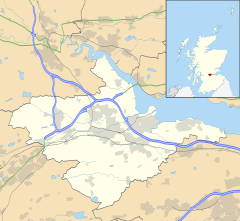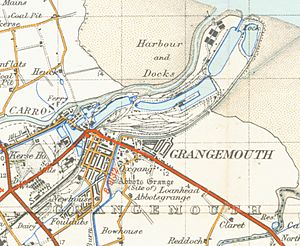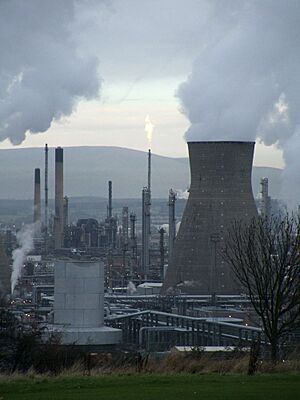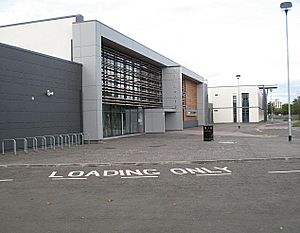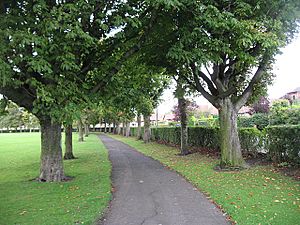Grangemouth facts for kids
Quick facts for kids Grangemouth
|
|
|---|---|
| Town | |
 A view over Grangemouth from Dumyat, December 2013 |
|
| Area | 4.12 sq mi (10.7 km2) |
| Population | 16,120 (2020) |
| • Density | 3,913/sq mi (1,511/km2) |
| Demonym | Portonian |
| OS grid reference | NS935815 |
| • Edinburgh | 21.0 mi (33.8 km) SE |
| • London | 345 mi (555 km) SSE |
| Council area | |
| Lieutenancy area |
|
| Country | Scotland |
| Sovereign state | United Kingdom |
| Post town | GRANGEMOUTH |
| Postcode district | FK3 |
| Dialling code | 01324 |
| Police | Central Scotland |
| Fire | Central Scotland |
| Ambulance | Scottish |
| EU Parliament | Scotland |
| UK Parliament |
|
| Scottish Parliament |
|
| Website | falkirk.gov.uk/search/?q=grangemouth |
Grangemouth (Scots: Grangemooth; Scottish Gaelic: Inbhir Ghrainnse) is a town in the Falkirk council area of Scotland. It is located in the Forth Valley, right by the Firth of Forth. The town is about 3 miles (5 km) east of Falkirk and 13 miles (21 km) south-east of Stirling. In 2011, about 17,373 people lived in Grangemouth.
Grangemouth grew mainly because of its great location. It started as a busy port when the Forth and Clyde Canal was built in the 1700s. Today, the town's economy mostly depends on its large petrochemical industry. This includes the Grangemouth Refinery, which is one of the biggest oil refineries in Europe. Grangemouth is also twinned with La Porte, Indiana, in the U.S.A. People who live in Grangemouth are often called Portonians.
Contents
History of Grangemouth
Grangemouth was founded in 1768 by Sir Lawrence Dundas. This happened because of the building of the Forth and Clyde Canal. Workers first called the area "Sealock" because it was where the canal met the sea and flowed into the River Forth.
After Sir Lawrence Dundas passed away in 1781, his son, Thomas Dundas, asked an architect named Henry Holland to redesign the town. This included the area around the canal and its basin. The settlement then became known as "Grangeburnmouth" and later "Grangemouth." This name refers to its location at the mouth of the Grange Burn, a small river.
Growth of the Port and Trade
As more ships and canal boats came to Grangemouth, the town became richer. This was partly because the port of Leith had high fees, so many ships chose to use Grangemouth instead. Also, the River Carron was made deeper for larger ships. New coal mines north of the town also helped increase trade, especially with countries around the Baltic Sea.
Grangemouth also benefited from being downstream from the famous Carron Company. This company made cast iron products and weapons, which were shipped all over the world from Grangemouth. In 1810, Grangemouth got its own Customhouse. This was a stone building where ships could register their goods and pay fees.
Building the Docks
By the 1830s, about 750 ships visited the port, and over 3,000 trade journeys happened on the canal. The local shipyard also started building bigger ships. The harbor and river became too busy for all the ships. So, a new dock was planned.
About 200 men dug out what is now called the Old Dock. Lock gates were built, allowing ships to enter the port at any time, no matter the tide. This new dock also connected to the canal. This meant that timber logs from places like Scandinavia could be floated directly to sawmills almost a mile inland.
Over the next 50 years, the docks grew much larger. A big land reclamation project in the late 1890s moved the dock entrance closer to the Firth of Forth. This helped avoid the River Carron, which was not as deep or wide. The Grangemouth Dockyard Company was also started in 1885. Grangemouth Town Hall was completed in the same year.
Grangemouth During Wartime
In November 1914, during the First World War, the British Navy took over Grangemouth Docks. Merchant ships were not allowed to use them for the rest of the war. The dock was known as HMS Rameses by the military.
In 1936, an advert for the LMS said the docks had 121 acres of water. They also had direct access to the Forth and Clyde Canal, which connected to Glasgow and the Clyde. The docks handled 3,250,000 tons of goods each year. The Municipal Buildings were finished in 1937.
Economy and Industry

Grangemouth Port is one of the most important ports in the UK. It has Scotland's largest container terminal. About 9 million tonnes of goods pass through its docks each year. The port is well-connected to motorways, making it easy to move goods around.
The main industry in Grangemouth is the Grangemouth Refinery. This oil refinery is one of the biggest in Europe and provides many jobs for people in the area.
A building called the Soap Works used to make soap and glycerine. It was owned by the Scottish Co-operative Wholesale Society and started in 1897. This was the largest factory of its kind in Scotland and employed many local people. It was taken down in 2005 to make way for a new bottling plant for Whyte & Mackay.
Grangemouth also has groups for young people, like the Air Training Corps Squadron, an Army Cadet Detachment, and a Sea and Marine cadet corps. These groups help young people learn new skills and get involved in their community.
The town has two general health clinics and a dentist. Major hospital services are now at the Forth Valley Royal Hospital in nearby Larbert.
Education in Grangemouth
Grangemouth has four primary schools: Bowhouse Primary School, Beancross Primary School, Moray Primary School, and Sacred Heart R.C. Primary School. Most of these schools feed into Grangemouth High School. Sacred Heart R.C. Primary School sends its students to St. Mungo's High School.
Grangemouth High School was recently rebuilt. It now has new facilities like an indoor swimming pool, a dance studio, a gym, and an outdoor football pitch. For many years, Grangemouth had a three-level school system, which was unique in Scotland. This system ended in 1988.
Transport Links
Grangemouth has easy access to three nearby railway stations. These are Falkirk High, Falkirk Grahamston, and Polmont.
 |
Skinflats | Firth of Forth | Firth of Forth |  |
| Bainsford | Bo'ness | |||
| Falkirk | Polmont | Linlithgow |
Culture and Fun
Sports and Recreation
Grangemouth has a sports stadium and sports centre that meet international standards. Grangemouth Stadium was built in 1966. It has a 150-meter running track, a physio room, and a weight-lifting area. The stadium is used as the National Indoor Sports Stadium. In 2014, the running track used at Hampden Park for the 2014 Commonwealth Games was moved to Grangemouth Stadium.
There are several parks in the town for sports and fun. These include Inchyra Park, Rannoch Park, and Zetland Park in the town center. Grangemouth Golf Club is located in the nearby village of Polmont.
Football Teams
The town has many amateur football teams, such as Zetland AFC and Bowhouse F.C.
Places of Worship
Grangemouth has several churches, including three Church of Scotland churches, two Catholic Churches, and one Episcopal Church. There are also other mission-type churches and a Kingdom Hall of Jehovah's Witnesses. The closest Mosque is the Falkirk Islamic Centre.
Local Attractions
You can find The Kelpies and The Helix between Grangemouth and Falkirk. These are popular local attractions.
Twin Towns
Grangemouth is twinned with La Porte, Indiana, in the United States.
Famous People from Grangemouth
Many notable people have come from Grangemouth, including:
- Kaye Adams, a TV presenter
- Alan Davie, an artist and musician
- Elizabeth Fraser, a singer from the band Cocteau Twins
- Steve Frew, a Scottish gymnast
- Robin Guthrie, a guitarist and music producer, also from Cocteau Twins
- Stuart Kennedy, a footballer who played for Falkirk, Aberdeen, and Scotland
- Stuart Munro, a footballer for Rangers
- Sir John Ronald Peddie, known for his work with the Carnegie Trust
- Professor Gillian Reid, President of the Royal Society of Chemistry
- Isla St Clair, a singer and actress
- George Young, a footballer who was captain of Rangers and Scotland after the war
See also
 In Spanish: Grangemouth para niños
In Spanish: Grangemouth para niños


